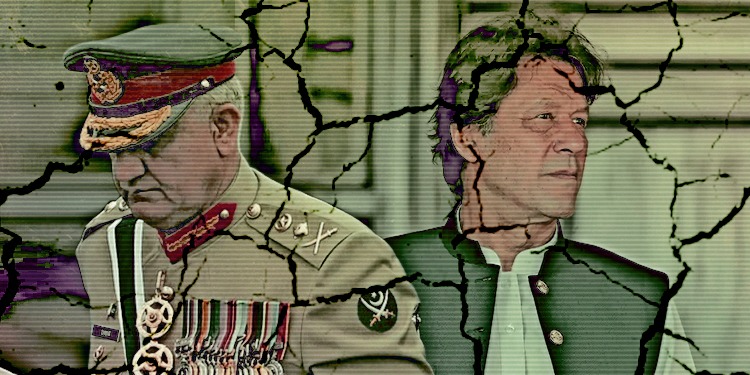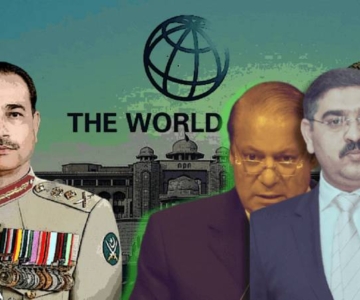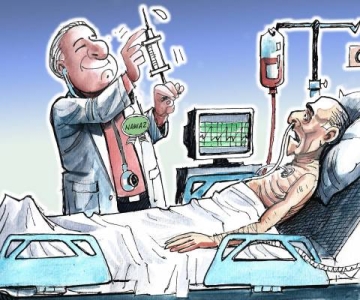The ‘hybrid regime’ that has been governing Pakistan since 2018 became hostage to internal contradictions and external pressures throughout the year 2021.
The year 2021 ended with a brewing political crisis and economic meltdown that was long in the making. During 2022, both these crises are likely to intensify — thereby resulting in regime change or mass protests which will pose yet another challenge to the Pakistani state — with serious implications for security and foreign policy choices.
The ‘hybrid regime’ that has been governing Pakistan since 2018 became hostage to internal contradictions and external pressures throughout the year 2021. On the political front, the PTI government led by Imran Khan lurched from one crisis to another; and was repeatedly rescued by the military establishment.
In April 2021, Shaukat Tareen was appointed as the PM’s Adviser on Finance mainly to salvage the economy that has been facing the twin pressures of high external borrowing and stagflation. Tareen promised that he would follow pro-growth policies and hinted that he was not ready to accept the IMF conditions in their entirety. He introduced an expansionist budget with higher allocations for development spending and attempted to revive the confidence of big business and investors to achieve increased economic activity, employment generation and stabilisation. However, by the end of 2021, it was clear that his efforts were leading nowhere as Pakistan’s quest for another IMF program required fulfilment of tough conditions that were going to increase the burden on the citizenry. During 2021, talks with the IMF could not yield positive results and in early months of 2022, further rounds of talks are likely to take place with an uncertain outcome.
The IMF program is likely to be approved but it will come at a high cost: further devaluation, increased taxes and slashed public spending on development.
Governance: Rule-by-Ordinances and reckless inconsistency
The economic woes of Pakistan are a direct result of poor governance and mismanagement at the highest levels of the government. During 2021, heads of Federal Board of Revenue (FBR) and secretary finance were frequently changed — thereby creating a new record of reckless inconsistency. The parliament barely met for legislation during 2021 and the PTI government continued to rely on ordinances. The majority of lawmaking took place via ordinances including the extension in the tenure of the National Accountability Bureau (NAB) chairman and other important matters concerning national governance.
By the end of the year, there was a long list of legislation to be approved and it was only with the intervention of the establishment that the PTI government managed to get 33 bills approved in the joint sitting of the house — creating a new record of instant legislation, circumventing the due parliamentary processes and setting dangerous precedents for the future governments. The rule-by-ordinance syndrome is symptomatic of the deeper governance crises whereby the government has little or no working relation with opposition and has been unable to create consensus on key policy issues. During 2022, this is likely to continue.
Emboldened Mullahs
The year 2021 was also the year of major victories for the new rising force i.e. Tehreek-e-Labbaik Pakistan (TLP). The group launched major protests in April and November, attacked and killed policemen, vandalised public and private properties and demonstrated that their street power was unmatched and unmanageable by the existing law and order apparatus. After both rounds of protests, the PTI government capitulated and signed truce agreement with the group. The November agreement is a secret document, details of which are yet to be made public. Ironically, many members of the cabinet confessed that they were not privy to the document that they were meant to approve. And yet, they went ahead and approved it. During the second round of protest, the TLP wanted to march to the federal capital, and the negotiations were led by the army chief himself — with the assistance of regime-friendly clerics and wealthy businessmen of the majoritarian Barelvi sect. The hapless PTI government seemed ill-equipped to manage this crisis. And during 2022, the TLP — emboldened by its 2021 successes —will likely be back on the streets.
After decades of overt and covert support to the Afghan Taliban, and the US resolve to get out of the country, led to the dramatic fall of the Kabul regime; Pakistani government and many sections of the society celebrated these events — perhaps even more than the Afghan population itself. In an ill-advised move, PM Imran Khan termed the Taliban victory akin to breaking the shackles of slavery.
However, developments since then have been ominous and worrisome. The Tehreek-e-Taliban Pakistan (TTP) launched a number of attacks on Pakistani security personnel and this is why terrorism after years has emerged as a major challenge for the state. In December alone, TTP claimed responsibility for 45 attacks. The TTP is now a major threat to Pakistan’s internal security while the Afghan Taliban that have not been recognised by the world yet are turning out to be a liability for Pakistan. But Pakistan’s old-school security worldview continues to consider Afghan Taliban a vital strategic asset in keeping India away from Pakistan’s western borders.
Sadly, the Afghan people and their sufferings have increased manifold with millions facing malnourishment, unemployment and an extremely uncertain future with closed borders preventing their escape from a country that is yet to find a peaceful resolution to its internal conflict. This will turn out to be a biggest challenge for the year 2021. Pakistan continues to convince the world to recognise the Taliban regime, extending humanitarian assistance to the Afghans and managing the TTP threat which is here to stay.
Relations with India remained tense with little or no sign of normalcy and are likely to remain troubled until there is an external intervention or display of initiative by the two countries who remain hostage to their own right-wing constituencies.
The Afghan people and their sufferings have increased manifold with millions facing malnourishment, unemployment and an extremely uncertain future with closed borders preventing their escape from a country that is yet to find a peaceful resolution
Fixing the Troubled Relationship with the West
The most crucial of developments during the year 2021 was the political and diplomatic estrangement of the US and its clear cut policy of not giving any relief to Pakistan in different international and regional contexts. President Biden not calling Imran Khan turned into a joke and the National Security Adviser in a weak moment told the Financial Times of Islamabad’s concerns. His otherwise direct statement was construed as a sign of Pakistan’s weakness and abandonment by a longtime ally. This is why tables turned by the end of 2021 with pro-establishment TV anchors arguing for mending relations with the US even if it came at the expense of slowing down the work on CPEC.
It is an open secret that the IMF will not sign off on a new program without a nod from the US government, the FATF will not give breathing space to Pakistan without US approval, and the European Union’s special trading facility GSP+ might also get influenced if the situation continues. While the military leadership is cognisant of the need to repair the relations with the US, the PM and his associates appear to be on a different track. Managing this crises at Pakistan’s doorstep will be a major worry of 2022 and might even become a reason for regime change. The US also influences Pakistan’s Middle Eastern allies such as Saudi Arabia, UAE et al and the choices before the country were never so clearer.
The ‘Islamisation’ Agenda Continues
Sadly, the year 2021 will be remembered for Imran Khan’s adventurism in contributing further to the radicalisation of the Pakistani society purely to gain short term political mileage. The PTI government rolled out the Single National Curriculum (SNC) across the country, contradicting the spirit of the 18th amendment that had shifted these powers to the provinces. But more than the legal lacunae, the SNC builds on the regressive curricula built by Zia ul Haq and diminishes the chances of improving the quality of education and changing the overall mindset of younger Pakistanis. During the year, magistrates in the Punjab were raiding schools to check if children were being taught the Holy Quran. The Punjab government ordered mandatory recitation of prayers in public schools, and the prime minister set up yet another religious authority to ‘counter Islamophobia’ and ‘protect the honour’ of Prophet Muhammad (PBUH). The head of this authority, soon after his appointment, turned into a subject of national controversy due to his anti-democracy and conspiratorial views and insistence on managing the country through an ‘elite of the elite’.
The PM’s other pronouncements competed with the TLP narrative and do not bode well for Pakistan’s future. Especially when the country has lost thousands to violence perpetuated by religious extremists and is a state-run laboratory of extremism. There are no signs that the year 2021 will see a reversal of these policies because Pakistan’s history tells us that undoing bigotry is next to impossible.
Media Freedoms, Human Rights and Shrinking Dissent
As the parliament remained unable to play a leading role in legislation, government accountability and overseeing citizen rights, the civil society and media faced tremendous pressure like the earlier years during the current hybrid regime.
The situation with respect to human rights was worrisome during 2021. Journalists Absar Alam, Asad Toor, among others were physically attacked. The former was shot in an Islamabad Park and the culprits are yet to be arrested. During the summer of 2021, Pakistan’s leading TV anchor Hamid Mir was taken off-air. Numerous other incidents of intimidation were noted. Online harassment often instigated by government officials attracted the attention of international media watchdogs.
Idris Khattak, a longtime human rights defender from Khyber Pakhtunkhwa province was presented before a military court and still faces trumped up charges of espionage among others. Ali Wazir, a member of the National Assembly of Pakistan from a tribal district of Khyber Pakhtunkhwa remained in prison for his criticism of the security forces. Wazir was granted bail in one of the cases against him but he remains incarcerated in another case.
The manager of a goods factory of Sri-Lankan origin was lynched to death during December 2021 for an alleged act of blasphemy. This brutal incident left the country shocked for days. The silver lining at the end was the acknowledgment by the PM of a factory staffer who tried to save him from the mob. He was awarded the Tamgha-e-Jurrat and almost the entire political elite condemned this incident. Nevertheless, the act of the mob – not the first one – is a sign of both radicalisation and weak law enforcement.
Challenges and Scenarios for 2022
Based on the above, the year 2022 is likely to present three major challenges for Pakistani state and society.
First, the unraveling of the hybrid regime which is already underway will not be completed without a major political crisis. The year 2022 is when the incumbent army chief retires and his successor has to be appointed by the PM. The PM in 2021 by dragging his feet on the issue of notifying the new DG of Inter Service Intelligence (ISI) made his choices rather clear. Not unlike the past, the civilian PM will get embroiled in a long drawn out conflict with the most powerful institution about this transition. This will be the driving force that will either push PM Imran Khan out of power or will consolidate him for the future.
Second, getting the IMF and international finance markets on board will be a major challenge that would require US intervention or assurances that will have to be agreed upon by both the civil and military leaders. Managing this tricky process may result in further friction within the hybrid regime and it will be a real test for the PM to navigate these trouble waters.
Third, the institutional decline will need to be arrested if Pakistan is to avoid domestic political chaos. Institutions such as the ECP, agreements on EVMs, issues of overseas voting and a long list of serious political changes has no buy in from the opposition parties which happen to be far more influential than Imran Khan thinks. The success of opposition parties in by-election, local bodies elections should have been an eye opener for the prime minister and his party that bulldozing new laws and rules without a consensus would get a serious backlash. It is unclear how the year 2022 will lead to a changed perspective, but a blanket push is not likely to work.
Lastly, the year 2022 will also be a year when the military establishment, nothing the seriously dysfunctional hybrid order in place, attempts to reset its relationship with political forces, the media and the civil society. Through the year 2021, the military was criticised by the sections of the media and political parties and a bulk of this criticism was articulated through social media which the hybrid regime was unable to completely gag or regulate. Individuals disappearances or attacks on journalists aside, the new media platforms are now arenas of political contests. And this will likely to intensify in 2022. As this ‘reset’ happens, Imran Khan will find his position more and more fragile and his survival in office will remain under threat.
Since the return of (diluted and now hybrid) parliamentary democracy in 2008, no prime minister has been able to complete his term, be it Yusuf Raza Gillani of Pakistan People’s Party or Nawaz Sharif of Pakistan Muslim League-N. The looming question at the start of 2022 is: how and why will Imran Khan be an exception to this trend? Even a bigger question is how would such instability lead to economic recovery?
This article was originally published in The Friday Times on January 9, 2022



